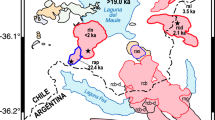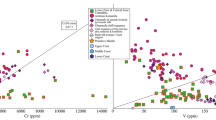Abstract.
Crystal chemistry and structural data for clinopyroxene from the Aeolian islands (Southern Tyrrhenian Sea, Italy) were determined with the aim of obtaining geobarometric information and exploring implications for the structure of volcanic plumbing systems. Cell and M1 site volumes for clinopyroxenes, which are known to decrease with increasing pressure of crystallization, revealed variable values, both within some single islands and along the entire arc, indicating polybaric conditions of crystallization. The lowest cell and M1 volumes were found at Filicudi, plotting close to values of clinopyroxenes from high-pressure ultramafic xenoliths entrained in alkali basalts. Indications of high-pressure crystallization were also found at Salina and, to a lesser extent, at Alicudi, all situated in the western sector of the Aeolian Arc. The central and eastern islands of Lipari, Vulcano, Panarea and Stromboli generally show higher values of cell parameters, suggesting crystallization in shallow magma chambers. These islands are characterized by the occurrence of large calderas, which are apparently lacking at Salina and Filicudi. Time-related variations were observed for cell and M1 volumes of clinopyroxene for some islands. At Salina, the early-erupted products display low values of cell parameters with respect to later activity, thus indicating a decrease in crystallization pressure with time. A similar, although less striking, pattern is observed at Alicudi and Lipari. An overall increase in cell parameters with time was observed at the scale of the entire arc. The observed variations in clinopyroxene structural parameters highlight the significance of pyroxene crystal chemistry for petrogenetic and volcanological interpretation. Correlation with time and the structural characteristics of volcanoes suggest significant regional and temporal modifications in the plumbing systems of Aeolian volcanoes. Clinopyroxenes from Filicudi and the older Salina crystallized at high pressure in deep magma chambers, in the lower crust or at the mantle–crust boundary. The lower crystallization pressure in the younger Salina is interpreted as evidence of upward migration of magma chambers with time. Similar evolution can be envisaged for Alicudi. Instead, the entire evolutionary history of the central and eastern islands was dominated by low-pressure crystallization, with formation of calderas and generation of abundant acid products that are scarce or absent in the western islands. Evolution of the plumbing system of single volcanoes and of the Aeolian arc in general is probably related to modification of stress regimes and/or thinning of the arc basement, due to the effect of uprising mantle material above the Ionian subduction zone.
Similar content being viewed by others
Author information
Authors and Affiliations
Additional information
Electronic Publication
Rights and permissions
About this article
Cite this article
Nazzareni, S., Molin, G., Peccerillo, A. et al. Volcanological implications of crystal-chemical variations in clinopyroxenes from the Aeolian Arc, Southern Tyrrhenian Sea (Italy). Bull Volcanol 63, 73–82 (2001). https://doi.org/10.1007/s004450100125
Received:
Accepted:
Issue Date:
DOI: https://doi.org/10.1007/s004450100125




